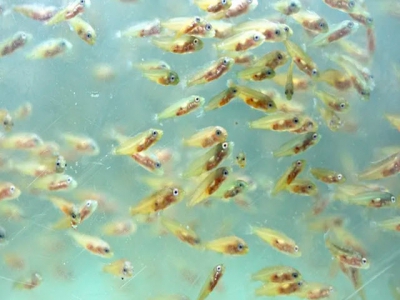Feed extrusion linked to deformities in farmed wrasse

A series of feed trials suggests that farmed ballan wrasse should not be given extruded feed, as it has been linked to the development of skeletal deformities, although further research is still required.
Ballan wrasse producer Mowi in Oygarden just outside Bergen, has been collaborating with scientists since 2012 to solve feed challenges. Photo: Jon-Are Berg-Jacobsen, Nofima.
Farmed ballan wrasse are used as cleaner fish in salmon farming. After hatching they are given live feed, before being weaned on to artificial diets and on-grown until released into salmon pens. Even though they are fed highly nutritious diets, they grow slowly and develop significant skeletal deformities, prompting several feed trials.
“We have now shown that technical feed quality is very important for fish welfare,” says Katerina Kousoulaki, feed scientist at Nofima.
Why?
Ballan wrasse have a very simple digestive system, lacking both stomach and pyloric caeca. Feeds that are processed differently affect digestion in ballan wrasse in a different way too.
“In the first trial, ballan wrasse larvae that were weaned onto dry feeds had a good appetite for the hard, extruded feed, and we saw good survival rates. After a few weeks, however, the fish started to develop skeletal deformities. Fish that were fed a soft, agglomerated diets, a type of feed that is processed at low temperatures, appeared to have far lower deformity rates,” says Kousoulaki.
The scientists then decided to make a single feed mixture, half of which was extruded, and the other half agglomerated. The feed was then tested in weaning ballan wrasse larvae. The results showed that after a month, extruded feed resulted in 41 percent fish with skeletal deformities, whereas under 2 percent deformities were seen in the fish that received the agglomerated feed. The body analyses of the ballan wrasse showed that those fed the extruded feed had barely taken up minerals from the feed, while fish fed the agglomerated feed showed good mineral status. The deformity rates correlated with the amount of phosphorus analysed in the body.
Nofima has a new CT scanner that can take three-dimensional images of the skeleton of whole fish. The image shows deficient bone mass in head and spine.
It was also shown that poultry meal in the feed may counterbalance some of the disadvantages of conventional extrusion. Cold-extrusion also resulted in higher mineral uptake compared to conventional extrusion, which takes place at high temperatures.
The scientists have developed a theory that high extrusion temperatures make feed minerals difficult to access for a fish species like ballan wrasse, which has no stomach or acid digestion. Ballan wrasse are also rather fussy when it comes to their diet. They like shrimp or krill and prefer little or no fish meal in their feed. Instead of fish meal, cod fillet meal is used, that hardly smells of fish but contributes to increased pellet hardness.
Senior scientist and fish welfare scientist at Nofima, Ingrid Lein, is the project manager of CleanFeed project. She believes that reducing the extent of deformities is essential for the welfare of the fish, and feed processing can play a role.
“What is clear from the trials is that conventional high temperature extrusion, which is normal for salmon feed, does not work for this fish species. However, there continue to be a lot of deformities in ballan wrasse despite the fact that feed companies are taking action, so I think that the problem is more complex,” says Lein.
In the scientific publication, the main conclusions are:
Hard, commonly extruded feed pellets used to wean ballan wrasse larvae resulted in skeletal deformities.
Softer, agglomerated feed particles resulted in higher mineral uptake in ballan wrasse larvae.
Extruded feeds resulted in higher fat levels in the liver and higher mortality rates in ballan wrasse juveniles.
Có thể bạn quan tâm
 Farmers in Mekong Delta rush to sell shrimp as price falls
Farmers in Mekong Delta rush to sell shrimp as price falls The Ministry of Agriculture and Rural Development has warned shrimp farmers to remain calm and refrain from selling large batches of white-legged shrimps
 Giant river prawns recover after long decline
Giant river prawns recover after long decline After a long period of decline, the last two years have seen an increase in output of giant river prawns in the Mekong Delta.
 Vietnam’s shrimp export goal faces imminent failure as farmers close ponds
Vietnam’s shrimp export goal faces imminent failure as farmers close ponds Vietnam’s goal of exporting $10 billion worth of shrimp in 2025 is facing a grim future as farmers are closing ponds after consecutive losse
 Tra fish exports to China continue to thrive
Tra fish exports to China continue to thrive Vietnam’s tra fish (pangasius) exports to China continued to record year-on-year strong growth of 43 percent to 145 million USD in the first four months of 2018
 Seafood shipments to EU drop
Seafood shipments to EU drop Shipments of seafood, excluding fish, to many markets, especially the European Union (EU), showed signs of reduction recently